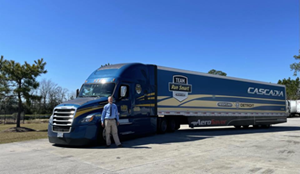

Most of us are familiar with the childhood story of Goldilocks and the Three Little Bears. In this story, a level of importance is given to having the porridge at just the right temperature. Whether it's temperature or right-sizing many things in life, getting it just right is often of the utmost importance. We don't bring a dump truck when all we need is a wheelbarrow. We don't use a two-and-a-half-pound sledgehammer to install a tack to hang a picture on a wall.
On our trucks, for many years now, there have been air-ride seats to adjust the height of the driver in regard to the control points of the vehicle. Having the seat suspended by air also leaves room to adjust the spring rate in accordance with the driver's weight.
It has become commonplace to use an air ride suspension on our trucks and, in many cases, our trailers. Using an air spring allows for the spring rate to be adjusted according to the amount of cargo being transported. Prior to the air ride suspension, they tried to do this through the use of steel taper leaf springs which put more leaves in contact to support the additional weight. The heavier the weight on a leaf spring suspension, the more leaves would come into contact to support the extra weight.
I think you see a pattern here, where we try to have the correct size tool for the given task. For many years now, the heavy haul and construction segments of the transportation industry have employed the use of lift axles to adjust their footprint based on the requirements of the load on hand. They get quite creative with this on their trailers with the use of Jeep dollies and flip axles.
The part of this subject that continues to baffle me is why the line haul on-highway segment of our industry seems to prefer having the same amount of axles supporting the load regardless of the task at hand. There is a large portion of freight that does not require the footprint of five axles on the ground. Adding to this is the amount of less-than-truckload shipments that often get lighter as deliveries are made. In many operations, especially short haul, there is often a percentage of empty miles to be considered when determining how many axles are needed to support the load. Having an extra axle on the ground is not only a waste of tires and fuel, but in many cases, it will contribute to higher charges on a toll road.
For all the reasons mentioned in the above paragraphs, I have been a huge advocate of utilizing liftable axle suspension components on the truck and the trailer as well. Just last week, I completed two shipments where I was able to operate legally on one trailer axle along with having one axle lifted on my three-axle power unit for over three thousand six hundred miles.
At the end of the day, there is more freight that will cube out before weighing out than many people realize. My thoughts are that much like the heavy haul industry, we should have the right amount of axles supporting our loads for the shipment which is being transported. There is no reason why we should be driving around with five axles on the ground when they are not needed, unless we are pulling a set of pups in a doubles configuration where it is not possible to lift any of the axles, because they are all needed to support the truck, trailers, and converter dolly.
This is why I utilize the Hendrickson Optimaax liftable 6x2 axle configuration on my power unit along with the Hendrickson under-beam lift kit on my trailer. By using these two components from Hendrickson, I am able to “right size” my axle configuration for the job ahead.
In the end, having the right amount of axles for the job is similar to many of the lessons put forward in the stories that we heard in our childhood. So, take a lesson from Goldilocks and look into employing, in our case, a suspension system that gets it “Just Right”!